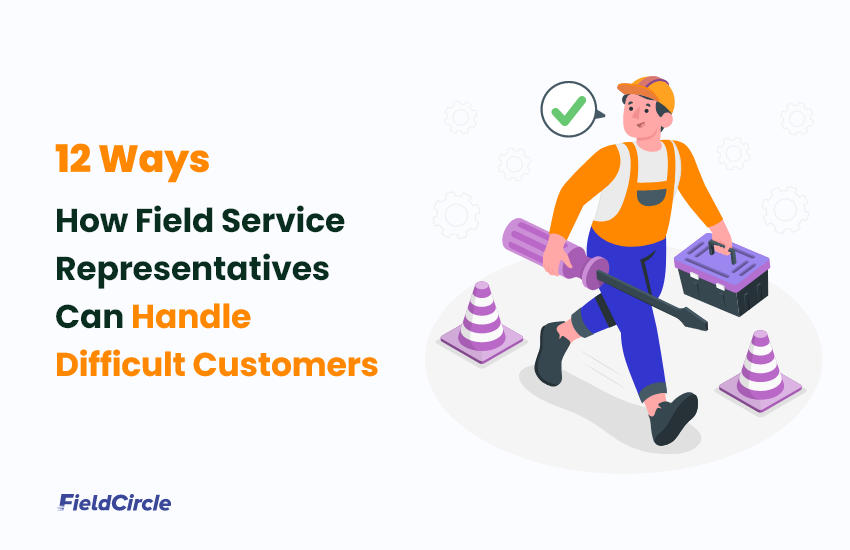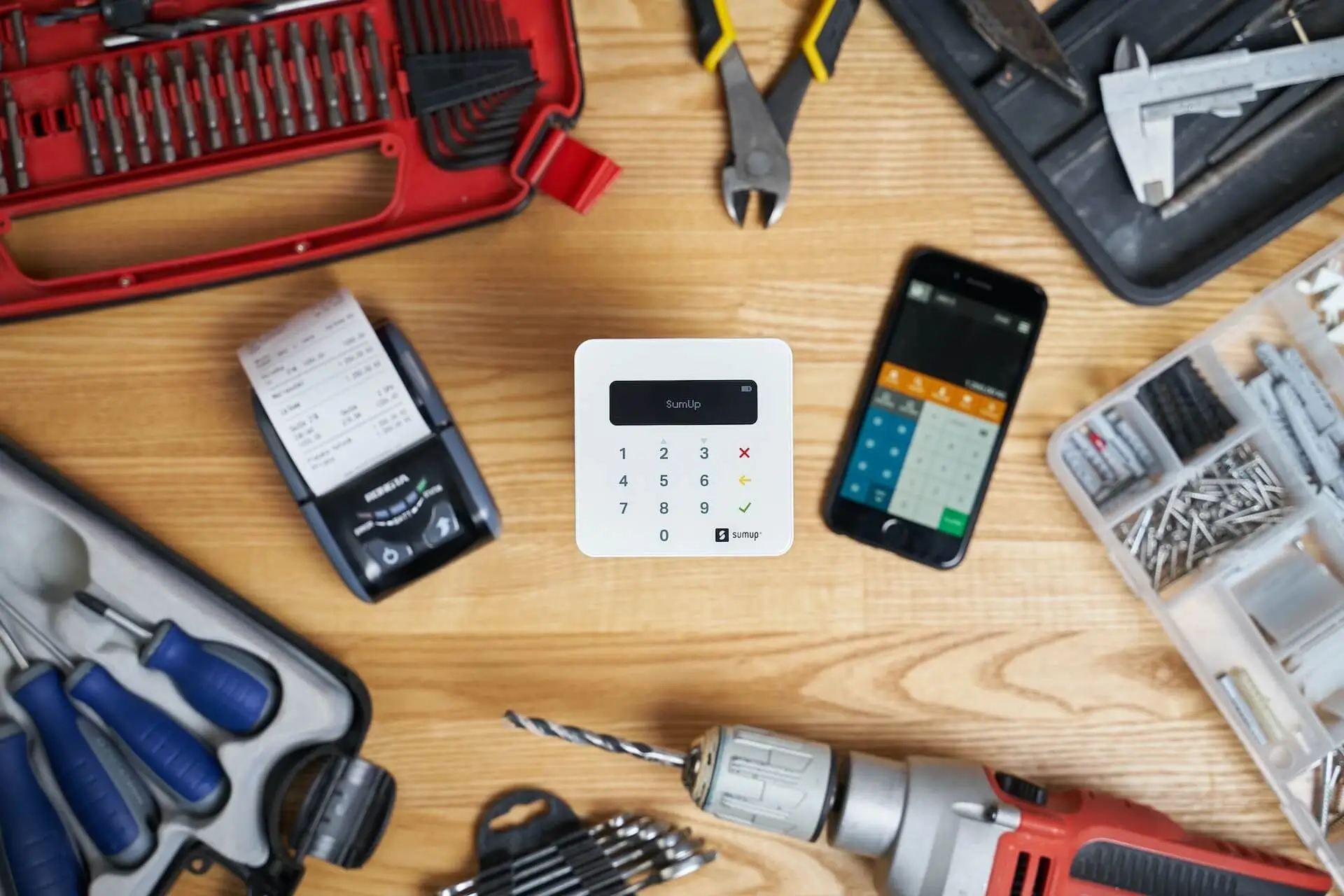12 Ways How Field Service Representatives Can Handle Difficult Customers

Dealing with a difficult customer is a challenging task for every business. But how you are approaching a problem could mean the difference between retaining a loyal customer or losing them to a competitor. Studies say that 64% of business leaders say that customer service has a positive impact on their company’s growth. However, finding a single solution that satisfies every type of customer is not always a walk in the park, as every customer is unique and has varied expectations.
Your customers might be having a terrible day, and a minor issue could be their last straw. While dealing with demanding customers may seem insurmountable, ensuring that even the most challenging clients have a positive customer experience is essential. A single misstep can lead to negative reviews on social media or churn, resulting in lost business. As per studies, around 76% of consumers say they would rather do business with a competitor on a single instance of bad experience. Mastering the art of handling demanding customers and providing excellent customer support can help you create a positive customer advocacy strategy while contributing to your organization’s brand value. Let’s dive deep to understand how to achieve this target.
Strategies For Handling Difficult Customers in The Field Service Industry
Dealing with difficult customers in the field service industry can be tough, but it’s crucial to maintain customer satisfaction and trust. To do this, it’s essential to communicate effectively with challenging customers and gather real time customer feedback. Knowing the common types of difficult customers is the first step, and there are some tips you can use to make these conversations a little easier and provide excellent customer service. A big part of managing such interactions effectively comes down to strong field service communication—how technicians and support teams convey information, set expectations, and resolve issues on-site or remotely. Below, we’ll explore each point using a real-life scenario from the field service industry.
1. Understand the Customer’s Psychology
It is important for technicians also to utilize psychological skills to assess the customer’s personality type. While most customers have valid reasons for being upset, some have a tendency to create a hostile environment and use stress to manage their service providers. Additionally, some customers may exaggerate their issues in order to receive financial compensation. In such cases, technicians should inform the customer that they are not authorized to make such financial decisions, but can refer the matter to the appropriate department.
If the conversation becomes circular and unproductive, technicians can request to speak with a technical employee of higher authority and maintenance experience to gain further insight into the issue. Alternatively, technicians can arrange for an expert or team leader from their company to participate in a phone or web conference with the customer, which may help to diffuse the tension. This often results in the customer providing a more concise and less heated explanation of the problem, contributing to more effective field service customer engagement and resolution.
2. Active Listening:
Imagine a scenario where one of your field service technicians is dispatched to a customer’s location to carry out a repair service. The customer, who is dealing with production delays due to the machine’s breakdown, is visibly upset and frustrated. To handle this situation effectively, it’s crucial that our technician possesses the critical skill of active listening. This involves attentively and patiently listening to the customer’s complaints without interrupting, while paying close attention to every detail provided. By using open-ended questions such as, “Could you please elaborate more on the issues you’re facing?”, your technician can gather important information that aids in resolving the problem swiftly. Demonstrating active listening to customers goes a long way in making them feel heard and valued, which ultimately leads to increased customer satisfaction.
3. Empathize:
It’s important on the part of your technician to remember that active listening is only part of the job. Demonstrating empathy is equally crucial. Let’s say you have a customer who is frustrated and upset due to production delays, which have resulted in financial losses. In such a scenario, it’s important to show understanding and compassion. By acknowledging their concerns and expressing empathy, your representative can help ease their stress and reassure them that you are genuinely interested in helping them. When your representative demonstrates empathy, it portrays your concern for your customers, that you care about their well-being and understand their situation. This helps to build a positive emotional connection, which, in turn, increases their overall satisfaction with your field service experience.
4. Stay Calm and Professional:
In a situation where a customer becomes increasingly agitated and blames your company for a breakdown, it is essential that the technician maintains composure and professionalism. Reacting emotionally can only worsen the situation, and the customer may feel unheard or invalidated. Therefore, the technician should respond calmly and professionally, acknowledging the inconvenience caused and proposing to work together to find a solution.
It’s important to note that a bad customer experience can have significant consequences for businesses. Studies show that on average, 49% of customers leave a company due to poor customer service. Therefore, it’s crucial to handle challenging situations with professionalism and empathy. This approach reassures customers that they are dealing with a competent and reliable service provider, which can enhance their satisfaction and confidence in your organization.
5. Apologize:
Apologizing sincerely is a crucial aspect of good customer service. In situations where a customer is frustrated due to frequent breakdowns and demands an explanation and immediate resolution, offering a heartfelt apology is important. Your technician should acknowledge the customer’s inconvenience with phrases like “I’m sorry for the repeated issues you’ve experienced with our machine”. This helps to empathize with the customer and take responsibility for the problem. A sincere apology acknowledges any inconvenience or issues the customer has faced, which demonstrates accountability and a commitment to making things right. By doing so, it can significantly boost customer satisfaction and help to retain their loyalty.
6. Seek to Understand:
When a customer shares that previous service visits did not solve their problem, it is important for our technician to seek to understand the history of the issue by asking clarifying questions. This includes inquiring about the details of previous service visits and what was done to address the issue. By gathering this information, our technician can tailor their approach to ensure a successful resolution. By asking clarifying questions and understanding the customer’s concerns, our technician demonstrates a dedication to addressing their specific needs. This tailored approach can lead to more effective solutions and increased customer satisfaction.
7. Offer Solutions:
Once the issue is diagnosed and a solution is identified, the technician should offer clear and concise solutions to the customer. For example, if a critical component needs replacement and is readily available in stock, your representative can explain the situation and offer to install the replacement part immediately, getting the machine back in operation.
In the scenario where a customer has had previous service visits that did not solve the problem, our technician should approach the situation by asking clarifying questions to gain a better understanding of the history of the issue. For instance, they may ask, “Can you tell me more about the previous service visits and what was done to address the issue?” This approach will help our technician gather the necessary information to tailor their approach and resolve the issue successfully.
8. Be Patient:
In situations where a customer is feeling anxious and is seeking an immediate solution to their problem, even if it means that the repair process will take some time, it is important for our technician to remain patient and understanding. It is imperative that the technician takes the time to explain to the customer the necessary duration for a proper component replacement and reassure them that they will work as efficiently and expeditiously as possible to minimize downtime. Demonstrating patience and a willingness to invest the necessary time to address the issue, even in the face of customer urgency, can lead to a more comprehensive and effective problem-solving process, ultimately resulting in increased customer satisfaction.
9. Set Realistic Expectations:
When a customer has high expectations of a quick resolution, it’s crucial that our technician communicates a realistic timeframe for the repair. This involves estimating the number of hours required for the repair and committing to keeping the customer updated on the progress. Clear communication of what to expect helps to manage their expectations and can lead to increased satisfaction. For instance, the technician could say, “I estimate it will take about X hours to complete the repair, and I’ll keep you updated on the progress.” This helps the customer to understand the service process and timeline, setting accurate expectations and reducing the likelihood of disappointment. Managing expectations is key to delivering excellent customer service.
10. Let the Customer Collaborate:
When a customer expresses their desire to be involved in the repair process, our technician should warmly welcome their participation. The technician can offer to provide a detailed explanation of each step involved in the repair process while allowing the customer to observe and even participate. By fostering a sense of collaboration and transparency, this approach creates a partnership between the customer and the technician. This partnership can lead to more effective problem-solving and successful repairs, ultimately resulting in greater customer satisfaction.
11. Initiate a Rational Thought Process in Customer
After the customer has finished explaining their situation, technicians may ask additional questions and ensure they fully comprehend it. It’s crucial to keep in mind that dissatisfied customers may want to express their displeasure and may overlook the factual aspects of the issue. Thus, it is the duty of the technicians to bring them back to a reasonable and logical thought process.
The customer’s anger could be associated with logical or illogical factors exceeding the pressure caused by the equipment malfunction. For example, it could be triggered by a violation of the contract, such as non-compliance with response times, or by several breakdowns of the same equipment.
If technicians are part of the problem, they should make amends and explain themselves. If the issue is related to previous service, such as an incomplete maintenance operation, technicians should not criticize their colleagues but apologize on behalf of the company. The majority of the latest generation of field service applications allows technicians to access the history of disputes related to the account, as all service carried out at a site is documented. They can utilize all this information to bring back rationality in the customer.
12. Follow Up:
After completing a repair, it’s always a good practice to follow up with the customer to ensure that everything is running smoothly. This not only helps in building trust but also leaves a positive impression on the customer. A simple phone call or email can go a long way in establishing good customer relations. Following up after service completion shows that you care about the customer’s ongoing satisfaction and are committed to ensuring the service meets their expectations. It’s an opportunity to address any lingering concerns and solidify satisfaction.
To ensure the best possible outcome, it’s recommended to wait a few days before following up with the customer. This gives them ample time to test the repaired item and identify any issues that may have been missed during the initial repair. During the follow-up call or email, it’s important to ask specific questions such as “Is everything running smoothly now?” or “Do you have any other questions or concerns?” to encourage the customer to provide honest feedback.
In case the customer does have any concerns or questions, it’s essential to address them promptly and professionally. This ensures that the customer is satisfied and happy with the service provided, leading to positive reviews and word of mouth referrals. So, make sure to follow up with your customers after a repair, and you’ll be sure to leave a lasting impression.
Conclusion
As customer service is a field that is constantly evolving, it is crucial to keep up with the latest developments. Encouraging representatives or technicians to participate in continuous training and professional development opportunities can help keep their customer service skills up-to-date and fresh. These opportunities can include workshops, webinars, industry conferences, or online courses that not only enhance their communication skills but also contribute to better maintenance management by ensuring staff are aligned with the latest tools, systems, and service protocols.
According to research, 80% of people have an opinion that their customer experience is as important as products and services offered by the company.
When hiring new agents, use this list of strategies mentioned in this article as a checklist. Although all agents have different strengths, those who excel in the areas outlined above are more likely to become high performers.
Connect with us today to learn how FieldCircle can help you provide more efficient, transparent, and profitable field service operations.


